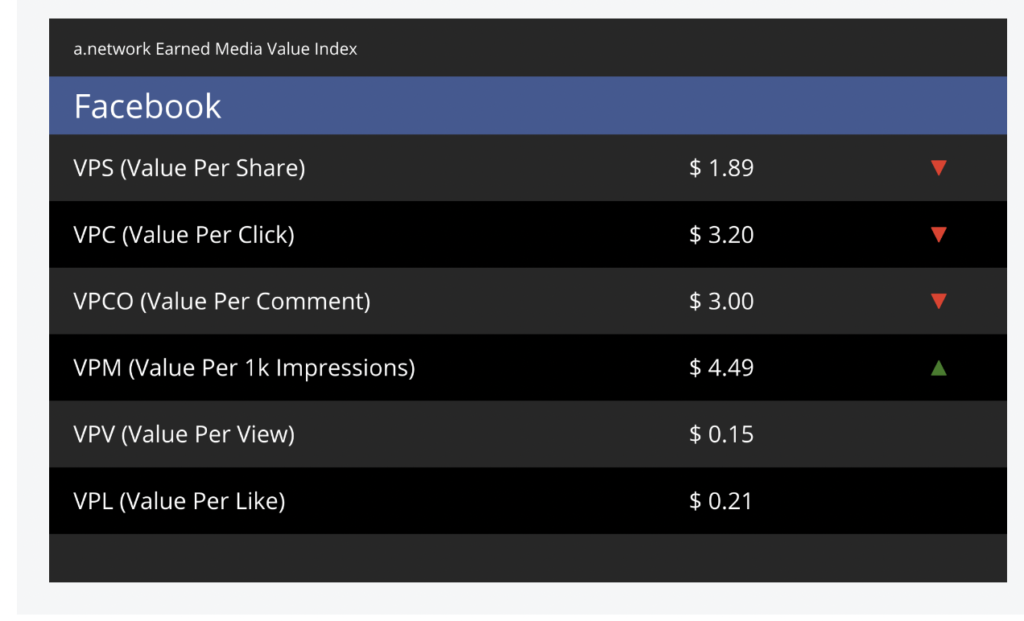As some of the world’s biggest companies—like General Motors and Dyson—halted their advertising campaigns citing concerns about brand safety, other brands and influencers, like Balenciaga and Gigi Hadid, have left altogether. With 92% of Twitter’s 2022 revenue derived from advertising, new owner Elon Musk has warned employees that the company could face bankruptcy. What’s a social media-focused marketer to do when a client or agency hits pause or delete on a specific social media platform? Look at earned media value.
What is earned media value – and why should it guide marketing decisions?
Earned media value is a metric that adds context and quantifiable value to social media content. It’s key to making decisions about what platform to use or abandon. Earned media value looks at more than clicks—it also examines results—the performance of content within the context of marketing and revenue goals. Earned media value’s data is exceptionally relevant because it looks at opt-in engagement, users voluntarily interacting with content in multiple ways beyond a simple click or a passive scroll-through. When looking at engagement rates on one social media platform or another, it can be helpful to have data-driven insights—or a tool like an earned media benchmarking index that can deliver real-time contextual data—around the clicks and comments that delivered the best results.
Each user interaction is assigned a value based on external, real-world insights through an earned media benchmarking index. This information can be used to guide short-term ad spend strategy pivots as well as long-term social media marketing plans.

Why earned media value matters more now
Despite Elon Musk’s recent efforts to calm skittish advertisers during a town hall, marketers have been vocal about their concerns about brand safety and Twitter’s future. That makes access to deep audience insights about social engagement performance critical to decisions about campaigns on new platforms and choices about pausing or ending Twitter media spending.
We spoke with the VP of Insights and Analytics at Ayzenberg’s marketing science division, Jocelyn Harjes, about the Twitter debacle.
“At Ayzenberg, we’ve believed in the power of social since the beginning,” stated Harjes. “As a practitioner, key moments in time have stuck out to me – Shoes (Kelly Song), Planking in 2012, and the Harlem Shake in 2013, Mark Zuckerberg testifying to congress explaining what Facebook was, and most recently Corn Kid + The Gregory Brothers bringing us the 2022 song of the year. Social media is a force that can be used to drive good or malice.”
The change in Twitter has been stunning, according to Harjes, and something that begs scrutiny.
“As Elon took over Twitter, we’ve seen the platform quickly succumb to trolls, as anyone could buy Twitter Blue and impersonate brands. Sure it was funny as the meme-makers utilized the Captain Phillips meme where the hijacker tells the captain that he’s Tom Hanks now. Still, it quickly became something to watch as an impersonator handle of Eli Lilly announced that insulin was going to be free.”
Twitter’s rollercoaster is now no laughing matter for brands and their marketers, according to Harjes. “Through this one tweet, we now have a quantifiable impact that social can have on the value of a company. Additionally, Eli Lilly lost billions of dollars in market cap due to one Tweet, only further supporting the need to understand your Earned Media Value and optimize your marketing efforts through its application.”
For marketers seeking to alter or pause a Twitter campaign, we’re sharing four tips to keep in mind below.
Focus on people, not platforms
Brands on Twitter or any other social media platform are looking for ways to connect with consumers when they are talking about or searching for information that might lead to a conversion. Since consumers search and discuss products and services on multiple platforms, marketers looking to reallocate budgets can look to platforms that deliver content or immersive experiences that spark these social conversations or searches. Platforms like Twitch, for example, can provide new opportunities to engage consumers through influencer content and high-impact video ads and present valuable social listening data that can inform future strategies. While social media platforms may evolve or disappear, social content will still be the most powerful way to create brand ambassadors and build brand awareness.
Deliver utility, not just content
Twitter’s core utility for consumers and brands is connected to its announcement functions—it can broadcast to millions, opens up conversations to a global audience, and provides real-time engagement data in a way that’s hard to duplicate. When it goes wrong—such as the recent faux free insulin announcement by a blue-check account that was not connected to the Eli Lilly company, results can be catastrophic for brands and marketers. Regardless of the future of Twitter—consumers will go where their digital experiences deliver a specific utility that they can’t get elsewhere. For marketers, that means a shift from “Here is what we want to tell you” to “Here is something you can use.” That engagement offer may take the form of a live stream with live comments or a metaverse event that delivers access to reusable downloadable content.
Rethink old ideas about audience segments
As Twitter’s ongoing challenges are causing marketers to rethink social media as a marketing channel, the audience may also merit a rethink. Consumers interact with Twitter for conversation and news, and creative brand marketers can deliver the same type of utility wherever there is an opportunity to engage with them; that means finding audiences wherever they are and learning how to connect with them in more efficient and enduring ways—beyond limited audience segments tied to a single platform. This may entail gleaning insights from new platforms and looking beyond traditional audience segments to broader cultural shifts, such as gaming.
Successful brand messages are really about values
Consumers are not leaving social media, even if its old format has evolved well beyond what it looks like today. Audiences congregate, interact and shop based on values—in every sense of the word. Marketers know how to craft messages to match what consumers care about on a heart level and a wallet level. Decoupling that skill from a single social media channel means translating that expertise into a new model of what social media is and may become. A consumer may be on Twitch while scrolling TikTok on their phone—they may voice search a product from Alexa and they won’t care where the content that delights and surprises them comes from. Marketers who understand the need for balance in messaging, frequency, and context will be able to find them and engage with them based on their old-school skills: wrangling data, creativity, and a deep understanding of their brand to connect—with or without that pesky blue check on their brand profile.


